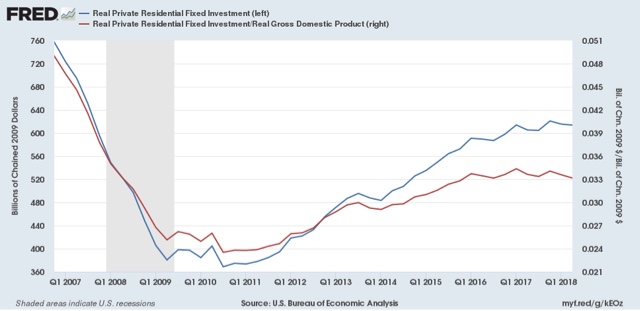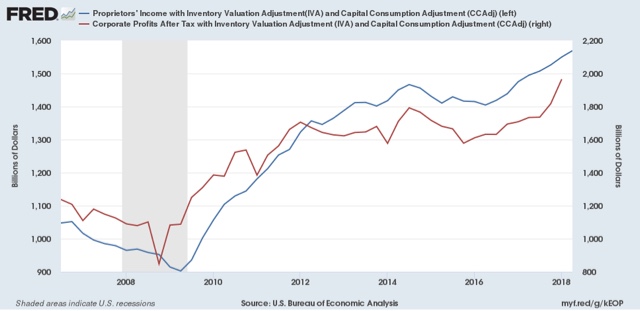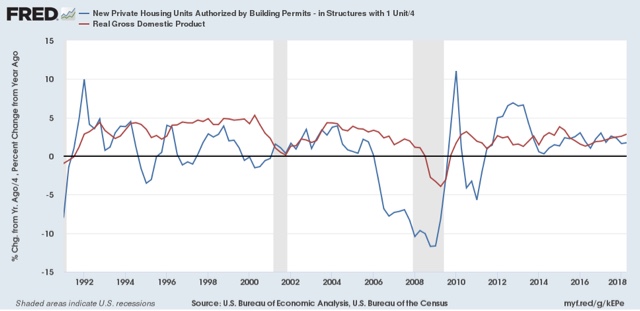Q2 GDP: likely as good as it is going to get this year [Note: FRED hasn’t gotten around to updating the GDP data. I’ll update this post once the graphs are available. UPDATE: Posted now.] This morning’s preliminary reading of Q2 2018 GDP at +4.1% was generally in line with forecasts. The coincident data, as I’ve reported in my “Weekly Indicators” column, as well as things like industrial production, the regional Fed reports, and real retail sales, have all been very positive for the past few months. So, “hurrah!” for the growth of one to four months ago. One point widely notied, which I’ll also repeat: exports added about 0.5% more than usual to the GDP number. This was almost certainly producers trying to get ahead of Trump’s trade wars, and will
Topics:
NewDealdemocrat considers the following as important: Featured Stories, US/Global Economics
This could be interesting, too:
Ken Melvin writes A Developed Taste
Joel Eissenberg writes How Tesla makes money
Angry Bear writes True pricing: effects on competition
Angry Bear writes The paradox of economic competition
Q2 GDP: likely as good as it is going to get this year
[Note: FRED hasn’t gotten around to updating the GDP data. I’ll update this post once the graphs are available. UPDATE: Posted now.]
This morning’s preliminary reading of Q2 2018 GDP at +4.1% was generally in line with forecasts. The coincident data, as I’ve reported in my “Weekly Indicators” column, as well as things like industrial production, the regional Fed reports, and real retail sales, have all been very positive for the past few months. So, “hurrah!” for the growth of one to four months ago.
One point widely notied, which I’ll also repeat: exports added about 0.5% more than usual to the GDP number. This was almost certainly producers trying to get ahead of Trump’s trade wars, and will likely subtract an equivalent percentage over the next quarter or two. In other words, GDP ex-frontrunning the trade war was about 3.6% annualized.
But will it last? As usual, my attention is focused not on where we *are*, or more properly, recently *were*, than where we *will be* in the months and quarters ahead.
There are two leading components of the GDP report: real private residential investment and corporate profits. Because the latter will not be released until the second or third revision of the report, I make use of proprietors’ income as a more timely if less reliable placeholder.
So let’s take a look at each.
Real private residential fixed investment actually declined slightly (blue). Measured by the more precise method of its share of the GDP as a whole (red), residential investment it was even more significant:
According to Prof. Edward Leamer, this typically peaks about 7 quarters before the onset of a recession. As it has not made a new high since five quarters ago, and must be considered a signficant leading indicator of recession at this point, although it is only down about half the percentage from its peak as the least amount prior to a recession (-3% vs. -6% before 2001).
On the other hand, proprietors’ income rose about 1.3% nominally in the second quarter. The below graph compares it with the less timely but more accurate corporate profits:
When discussing Q4 2017 GDP six months ago, I indicated that I wasn’t expecting any big surge due to the relative flatness or restrained growth in housing for most of 2017. The below two graphs show the leading relationship between housing permits (using the less volatile single family measure) and GDP broken up into two roughly 30 year periods:
Since the YoY% change in permits for 2015-17 was roughly 10% (divided by 4 for purposes of scale in the above graphs shows a number of ~2.5%), I wrote that a continued roughly 2.5% YoY growth of GDP for the next few quarters is a reasonable projection.
Obivously that wasn’t true for the second quarter, although YoY growth remains only +2.9%.
To reiterate what I said three months ago in response to Q1 GDP, while the economy is very likely to continue to grow through 2018, together this most recent data suggests a more questionable picture heading in 2019.
There is nothing in this morning’s strong Q2 GDP that causes me to change that view. All of the long leading indicators with the possible exception of corporate profits (for which proprietors’ income is a less reliable proxy) have continued to weaken, and there has been accumulating evidence in the monthly and even weekly reports that the important component of housing is at best very weakly positive and may even have tipped over to negative.




